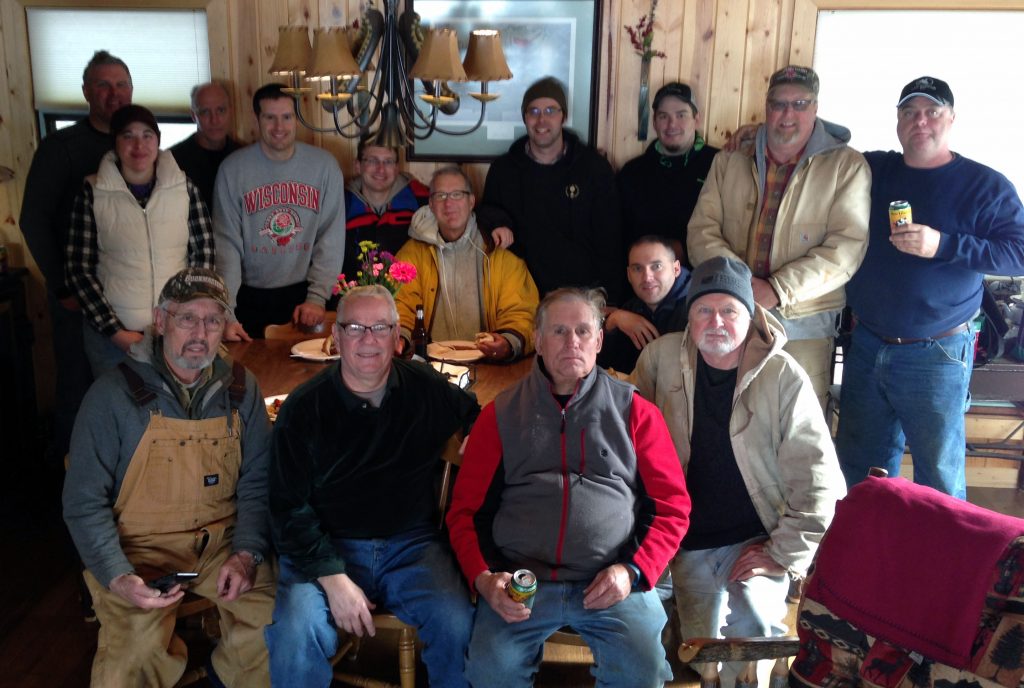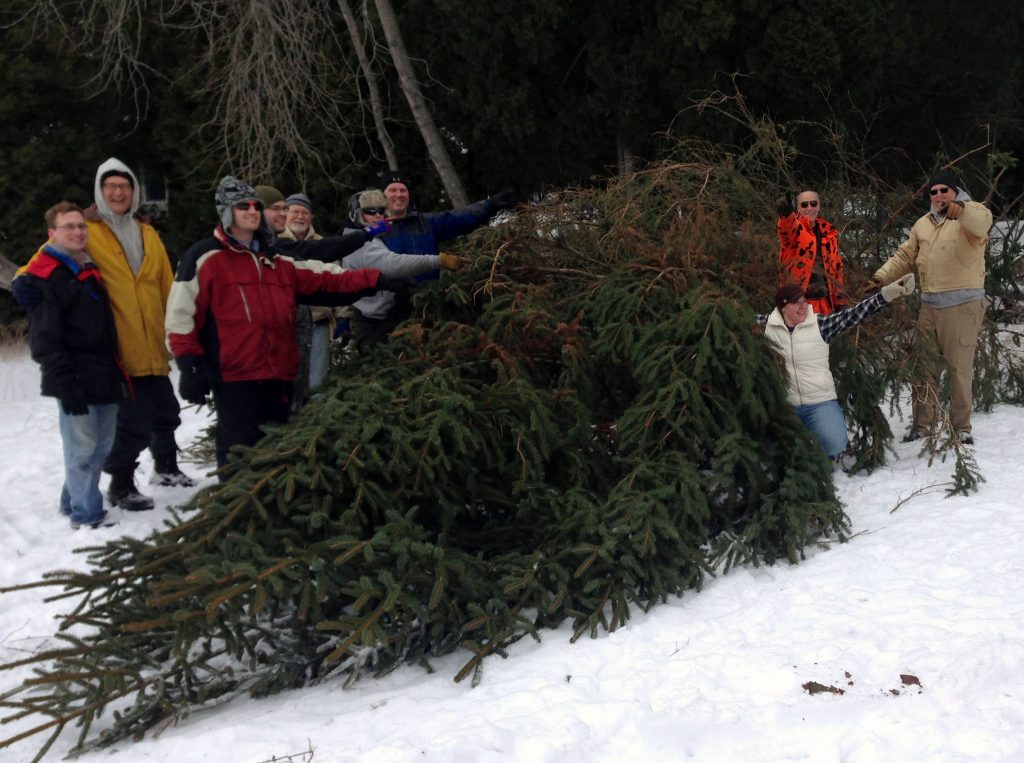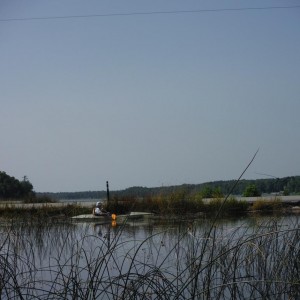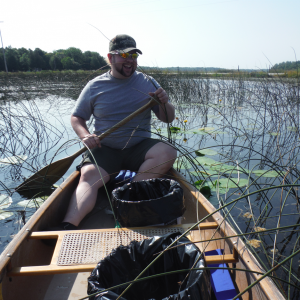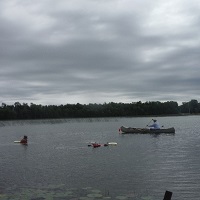Author: Tom Schneider
Kangaroo Lake: “Guys on Ice IV”
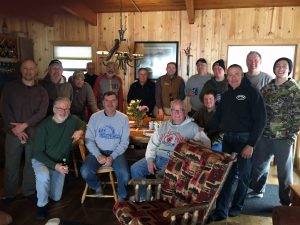
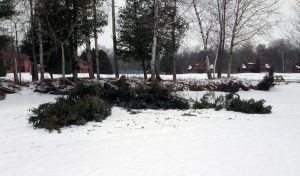
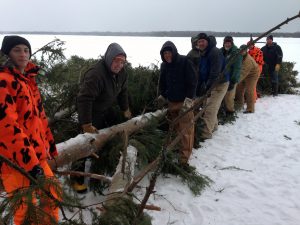
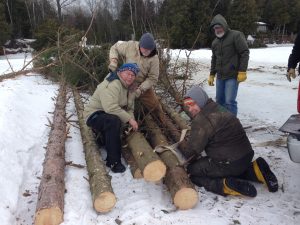
The Kangaroo Lake Association(KLA) and The Nature Conservancy(TNC) continued their “Fish Stick Partnership” on February 17, 2018 in Door County. “Fish Sticks,” are woody habitat structures that utilize whole cut live trees grouped together and secured to the shoreline, helping to restore shoreline habitat. This fish and wildlife habitat WDNR best practice creates food, shelter, and breeding areas for all sorts of creaures from small aquatic insets, frogs, fish, turtles, ducks, and songbirds.
Thanks to funding this year by the Lakeshore Natural Resource Partnership, our four-year efforts continued placing 23 more trees that are 35′-55′ in length. The Nature Conservancy owns land on Kangaroo Lake and needs to “thin” their forest area. Both organizations want to improve the woody habitat on the shoreline thus creating this ideal “win-win” opporunity. Most of the trees were Norway Spruce and Red Pine trees.
We reached a milestone in 2018 having placed our 100th tree in four years. We now have 28 “hosts” with 5 sites having multiple 3-tree complexes. The ice and weather conditions were perfect for our 18 volunteers who placed and secured the trees manually on the shoreline. A truck drags the trees to our various locations around the lake. Ninety (90%) percent of the life in a lake has its origins on the shoreline.
Here are a couple articles in the local paper on this year’s efforts: DC Pulse – December 15, 2017 and DC Pulse – March 2, 2018
For more information, contact Tom Schneider, Kangaroo Lake Association ([email protected])
608-217-9460 or TNC’s Mike Grimm, Conservation Ecologist ([email protected]) 920-743-8695.
We have great news: we’ve received new funding for additional Fish Sticks installation in February, 2018. But, we only have a few hosts and we need more.
We’d like to put in 30 trees again and have only 9 trees, or 3 complexes so far. We need your help in identifying hosts…your neighbor? friends? Would you be willing to reach out to them? A mailing is going to all land owners, but your personal invitation is what works the best. If someone is interested, please send their info to [email protected] and we will email them information right away.
We need to act now as they need to sign an agreement and we need to mark the location(s). If your place could handle more fish sticks, that would be awesome as well.
Please help now. Thanks for helping!
Author: Tom Schneider
On February 11th 2017, 18 volunteers dedicated themselves to improving the quality of water and habitat in Kangaroo Lake. The partnership of the Kangaroo Lake Association (KLA), The Nature Conservancy (TNC), and Wisconsin’s Department of Natural Resources (WDNR), and Harbor Lumber, Inc. of Baileys Harbor made it possible to install 33 trees (renamed “Fish Sticks”) that were 40-55 feet long on the shoreline ice on the lake. When the ice melts, the trees which are cabled to the shoreline trees, will drop into the water. Mother Nature’s “magic” will then begin.
These Fish Sticks will create new habitat for fish, frogs, turtles, song birds, ducks, many invertebrates, and become a new protective home for healthy lake plants including bulrushes. It is amazing that 92% of the life of the lake has its origin on the shoreline.
As development and construction has occurred on lakes in Wisconsin, the shoreline has been negatively impacted. Many trees, especially those that might fall into the water, have been removed. Many fish, like perch, lay their eggs on wood in the water. All kinds of minnows find protection from predators as they begin their life in the lake. The shoreline is also protected from erosion by the trees in water.
The KLA is striving to balance the “progress” of development with Mother Nature’s way of protecting the shoreline with woody habitat. Landowners are allowing the KLA volunteers to place Fish Sticks on the sides of their lake property. Volunteers including landowners are also planting bulrushes in the Fish Sticks to experiment with helping to bring back bulrushes that thrived at one time in the lake. Bulrushes are extremely healthy for the lake.
KLA’s volunteers the last three winters have placed 68 large trees perpendicular to the shoreline securing them with 3/8’s inch galvanized cable. None of these harvested trees have moved after ice out. They have been harvested by Harbor Lumber, Inc. from the property owned by TNC near the lake. TNC needs to “thin out” their forest by removing non-native trees for the long term health of the native forest. According to WDNR, they must be placed in the lake before March 1st to assure that they will not interfere with any fish spawning and consequently, will enhance the life of fish in the lake. This is definitely a “win-win” solution for all.
Two winters ago, KLA volunteers ventured out in -25 degree wind chill with blowing snow where they could not see more than 100 feet looking forward. Last year the opposite extreme occurred where they encountered melting ice, snow, and slush on the lake which made their work more treacherous especially hauling trees with Tom Anschutz’ truck.
This year, two weeks prior to Feb. 11th, leaders were prepared to call off this “adventure” because the ice was simply not safe enough. But, colder temperatures and no snow storms improved the ice for two weeks and the workers met at 8:00 on the ice and 33 degree mostly cloudy weather installed 33 Fish Sticks.
The video by Fox 11 TV Green Bay demonstrated the effort it took by 18 volunteers to move this large trees. After the team cut, hauled, dragged, lifted, grunted, caught their breaths, shared a great deal of humor, and cabled the large trees to the shore, they celebrated with a luncheon worthy of their efforts as good stewards of Kangaroo Lake and the environment around the lake in Door County. KLA will be looking for additional sites to place Fish Stick complexes for next winter. Yes, it felt like a new winter sport on the lake!
The WI-DNR’s Steve Hogler (our lake’s Fish Biologist) and Mary Gansberg informed our Association back in April that we were selected to receive a 2016 “Fisheries Partnership Award” for our region. The award recognizes an organization as a “partner who is going far and beyond” assisting WI-DNR in its mission. Only one award is given annually per each of the 5 regions in the state. The award recognizes the Kangaroo Lake Association for the tremendous work we’ve been doing “over the years.” This includes our Bulrush and Fish Sticks (Shoreline Restoration) efforts as well as our efforts with mapping and manually removing milfoil, water testing, website information and education, protecting shorelines with no wake buoys, fish cribs, other studies, etc. Here is the letter that Steve wrote nominating us for the award.
Members of the Kangaroo Lake Association (KLA) gathered at the Ridges Sanctuary in Baileys Harbor the morning of September 10, 2016 for the presentation of the award from the Wisconsin Department of Natural Resources (DNR). Here is an article in the Door County Pulse describing the celebration.
In 2014 we received a grant to help our shorelines, and we have begun work on our three-year project. Here is press coverage of the second 15 installations we did on February 20, 2016:
• KLA Press Release
• Door County Advocate – Kevin Naze Article
• Door County Pulse Article
Read Tom’s first-hand account of the day: Guys on Ice III.
We are beginning a list of members who want to host a Fish Stick complex in winter, 2017. For more information, contact Tom Schneider. Here’s more information on our Shoreline Preservation Grant.
On June 15, 2015, KLA’s representative, Wisconsin Lakes, sent a letter to Wisconsin’s Joint Finance Committee and the Legislature in opposition to the shoreland zoning restriction inserted into the state budget proposal. There were 59 lake and river associations and 32 counties including Door County, that sent the strong message: Don’t do it! Don’t insert this major change into the budget bill without public input because it has nothing to do with the state budget. This shouldn’t be the way we do the peoples’ business in Wisconsin. Motion #520 was included in the budget bill. Our state Assembly and Senate passed the bill and it was signed into law by the governor.
For almost 4 decades, the system of county-determined standards that could exceed the minimum state standards, worked for 30 counties and has served Wisconsin lakes very well protecting our lakes, shorelines, rivers, and streams.
Read more about this opposition:
- Wisconsin Lakes Efforts
- Door County Board of Supervisors Resolution
- Door County Directors of Planning and Zoning Department Letter
We encourage members to contact your representatives and inform them that “this isn’t the way we should do the peoples’ business in the State of Wisconsin.”
As part of the Door County Festival of Nature celebrated over Memorial Day weekend, Tom Schneider led two tours involving 13 participants to inspect and learn about the new “Fish Sticks” that were installed over the winter. Over the 75 minute gatherings, participants learned about how our KLA and The Nature Conservancy volunteers started and will continue to place significantly more trees on the shoreline of Kangaroo Lake as more lake property owners come to know the positive effects this strategy produces on the eco-system of our lake.
If you might be interested in placing a tree on your property, contact Tom Schneider.
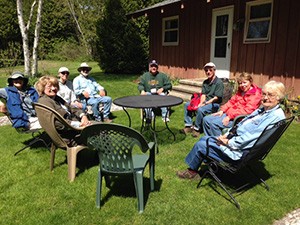
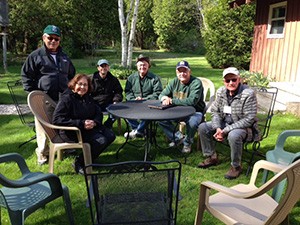
Photos of Festival of Nature Participants submitted by Tom Schneider
Also as part of the Festival of Nature, Paul and Marilyn Mahlberg led a hike on Saturday, May 23 and Sunday, May 24 in The Ridges Sanctuary, Logan Creek Park. The hikes lasted about 2 hours, going up and down through several different ecosystems. Each ecosystem displayed different trees and wild flowers, continually bringing interest to the hike. The hike also included a side trip to Clark Lake, which receives its water from Logan Creek.
Logan Creek Park is open to the public and can be found just southeast of Mr. G’s Supper Club.
There are many hikes at The Ridges, including guided hikes during the Festival of Nature Their new building (north of Baileys Harbor) will be open to the public on June 13. Go and visit it; while there, join The Ridges, to support its unique ecosystems and programs. They hold a range of programs for children (or grandchildren) and, of course, adults.
Our own Paul Mahlberg has been recognized by the Wisconsin DNR, the Wisconsin Lakes Partnership, and the Citizen Lake Monitoring Network for his dedication to observing Kangaroo Lake’s habitat for over 20 years. Check out this great statewide recognition of Paul (& Marilyn).
Paul, thanks for sharing so many of your gifts with us and many others on Kangaroo Lake!
In 2014 we received a grant to help our shorelines, and we have begun work on our three-year project. Here is press coverage of the first seven installations we did on February 14, 2015:
- Press Release from KLA & The Nature Conservancy
- Milwaukee Journal Statewide – Don Behm
- Door County Advocate – Kevin Naze
Read Tom’s first-hand account of the day: Guys on Ice II
We are beginning a list of members who want to host a Fish Stick complex in winter, 2016. For more information, contact Tom Schneider. Here’s more information on our Shoreline Preservation Grant.
Through cooperation between the Kangaroo Lake Association and the Nature Conservancy, Kari Hagenow will continue to coordinate volunteer efforts to remove Eurasian Water Milfoil (EWM) from the north end of Kangaroo Lake in 2015. EWM differs from and crowds out native milfoil and other native aquatic plants, which are beneficial. In 2014, volunteers removed approximately 250 pounds of the non-native invasive species, by pulling the plants from the roots and gathering in kayaks and canoes. Locations of EWM planned for future removal were mapped by GPS.
If you are interested in volunteering to help remove EWM and preserve the diversity of plants and habitat of Kangaroo Lake in 2015, please contact Kari at [email protected]. To learn more about EWM, please visit the Learning Center (See Education Paper #2 in our Learning Center).
Thanks to our 2014 volunteers, including Lucy Klug and Ryan Pesch!
Photos of Lucy Klug, Ryan Pesch and other volunteers submitted by Kari Hagenow
- « Previous
- 1
- 2
- 3
- Next »
